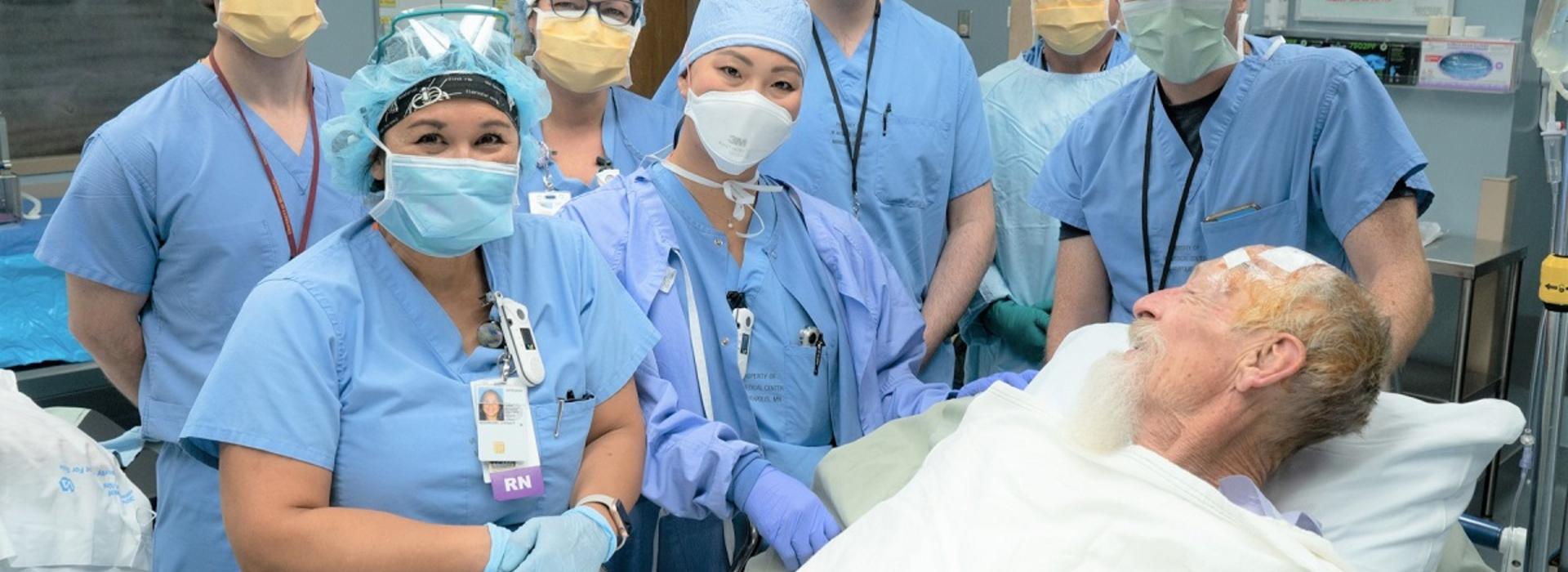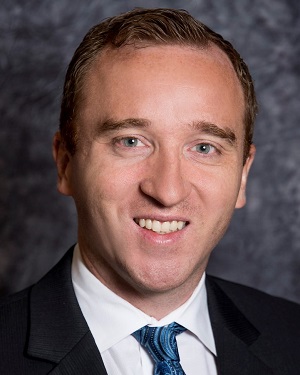
After years of preparation, first Veteran undergoes DBS procedure at the Minneapolis VA Medical Center
For almost a decade, the University of Minnesota has been working with the Veterans Administration to enable deep brain stimulation (DBS) procedures to be done at the Minneapolis VA Medical Center.
The first procedure was performed by functional neurosurgeon Robert McGovern, MD, November 24, 2021, on a Veteran from Wisconsin who had essential tremor. The collaborative DBS program is also working with Veterans who have other movement disorders such as Parkinson’s disease and dystonia.

This is a big deal for regional Veterans who want DBS to help minimize their symptoms from movement disorders such as essential tremor. “When these patients go to do something with their hands, the tremors occur,” said Dr. McGovern (pictured here). “It affects so many aspects of their lives – from taking a drink of water to writing a check to buttoning a shirt.”
Prior to the procedure being offered in Minneapolis, Veterans would have had to travel to San Francisco – multiple times – to get the surgery and complete their follow-up appointments.
Dr. McGovern has been at the forefront of this process. It was one of the reasons he was hired by the U’s Neurosurgery Department in 2018. “It’s taken a while to get this in place for Minnesota veterans,” said Michael Park, MD, PhD, who is also part of the department’s functional neurosurgery team and scrubbed in during one of the initial surgeries. “It solves two things: one, it makes it more accessible for Minnesota Veterans to get this therapy, and two, it makes it less onerous for the Veterans as they don’t have to travel to get the procedure done. We’re offering state-of-the art therapy to Veterans near where they live.”
Deep brain stimulation is the most common surgical treatment for movement disorders such as essential tremor, according to the International Essential Tremor Association. “With DBS,” the Association noted, “electrical stimulation is delivered to the brain through an electrode implanted deep into the VIM [ventralis intermedius] nucleus of the thalamus. It is the most effective treatment for tremor, with the greatest effect on hand and arm tremor, but it may also be helpful in controlling head, voice, and leg tremor.”
Some people with essential tremor prefer to just have their dominant hand treated. The Veteran from Wisconsin wanted stimulation for both of his hands. “We did the other side of his brain just before Christmas,” said Dr. McGovern. The second Veteran was scheduled for their first surgery to help treat Parkinson’s disease symptoms on January 12, 2022.
The surgery is done using microelectrode recording to map the area of the brain where the tiny stimulating electrodes will be placed. “We locate where we are three dimensionally,” said Dr. McGovern. “We can see and hear the brain cells, and work with an electrophysiologist to guide the electrode to where the brain cells are the most active. We also wake the patient up during the procedure and have them perform a series of movements. It helps us precisely locate where we should be in the brain.”

These images demonstrate the difference in the patient's tremors before and after the surgery.
The surgical team at the VA leaves about a month between surgeries for Veterans with essential tremor who choose to have both of their hands treated. “Because it’s a minimally invasive procedure, they go home the next day, but we want to give them some time to recover before we do the other side of their brain,” explained Dr. McGovern.
He is impressed by the strong collaboration between the University and the VA. “The multidisciplinary movement disorder program at the Minneapolis VA Medical Center is very strong and complements what we have at the U,” he said.
To further the collaboration, the VA’s surgical program was set up to mimic that of the University. “We use the same surgical protocols, and the VA made a big investment in the same electrophysiological recording rig needed to accurately place the electrodes,” said Dr. McGovern. The similarities also made the VA an extension of the U’s movement order research. “It will help us expand the pool of people eligible for our studies,” he noted. “It has been a privilege to have been part of enabling regional Veterans to have better access to this therapy and to perhaps participate in important movement disorder research.”



